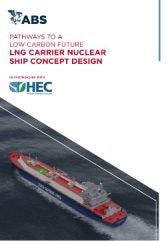
The American Bureau of Shipping (ABS) has released a new report Pathways to a Low Carbon Future LNG Carrier Nuclear Ship Concept Design to address challenges to nuclear technology at sea. The 14-page report looks at the potential of advanced nuclear technology for maritime applications, with a study of a small modular reactor (SMR) on a standard liquefied natural gas (LNG) carrier.
The transformational impact of a high-temperature, gas-cooled reactor (HTGR) on the design, operation and emissions of a 145,000 cubic metre LNG carrier design was modelled by ABS and Herbert Engineering Corporation (HEC). ABS says the study is designed to help industry better understand the feasibility and safety implications of nuclear propulsion and to support future development projects.
It provides information on heat and energy management, shielding, weight distribution, and other design features for an LNG carrier with nuclear propulsion. “This will assist the identification of design issues that will inform future Rules development,” ABS notes. The study also found the HTGR technology allowed faster transit speeds and offers zero-emission operations. There would also be no requirement to refuel, although the HTGR technology would need replacing approximately every six years.
“While this technology is well understood on land, adapting it for marine application is in its infancy,” said Patrick Ryan, ABS Senior Vice President and Chief Technology Officer. “However, this study and the other research we have carried out clearly highlight its significant potential to address not only shipping’s emissions challenge but to deliver a range of other operational advantages to the industry. ABS is committed to helping the industry evaluate its suitability for use in a range of use cases and LNG carriers is just one of a range of potential applications we are exploring.”
The study shows a nuclear propelled LNG carrier would have specific design features, with reactors placed at the rear of the vessel and batteries forward of the location occupied by fuel tanks on current vessels and a reinforced hull. Given design constraints, the HTGR technology would only be suitable for larger LNG carriers.
The main conclusions of this study are:
- Nuclear power would be an ideal means of drastically abating shipping emissions, but significant hurdles remain in public perception and international regulations before this can be achieved.
- The use of nuclear power on board commercial vessels can contribute to significantly more efficient ships in terms of transportation capacity.
- The maturity of advanced nuclear technologies that may be implemented for ship propulsion is low. Therefore, the level of detail provided in the study is limited to engineering information available from the design of terrestrial applications for engineering postulation and recommendations for future design optimisation.
- The modular reactor philosophy imposes significant restrictions on ship design. The modularity concept imposes a fixed maximum SMR power output per reactor, corresponding to a set lifespan of its core. Although it is possible to operate an SMR at a lower constant power level, its core will last longer. This may cause the reactor end-of-life to not line up with the ship’s standard drydocking schedule, thus imposing significant additional operational costs. This means that SMRs would be better suited for just a few sizes per ship type (mostly larger ships).
- The ability of nuclear power plants to tolerate higher accelerations due to ship motions and vibrations can allow for flexibility in the overall design. While there are significant safety benefits to keeping the plants at midships, for specific vessel types like oil tankers and LNG carriers, the midships location would not be feasible or would significantly penalise cargo capacity.
- It is advantageous if the nuclear power plant equipment and fuelling lifecycles align with the vessel’s life. Challenges with access to suitable shipyards or other support facilities and the physical removal of the reactors are major concerns, which would be simplest to avoid by addressing the issues in the design stages.
- The degree of redundancy required by a nuclear-powered vessel may be higher than a more conventionally powered vessel for safety, which causes a decrease in performance.
- Opportunities for optimisation exist on many levels for future design iterations.
Earlier in October, ABS launched the industry’s first comprehensive rules for floating nuclear power plants at a forum for nuclear industry leaders held jointly with Idaho National Laboratory (INL). In 2021, the US Department of Energy (DOE) has awarded ABS a contract to research barriers to the adoption of advanced nuclear propulsion on commercial vessels.






